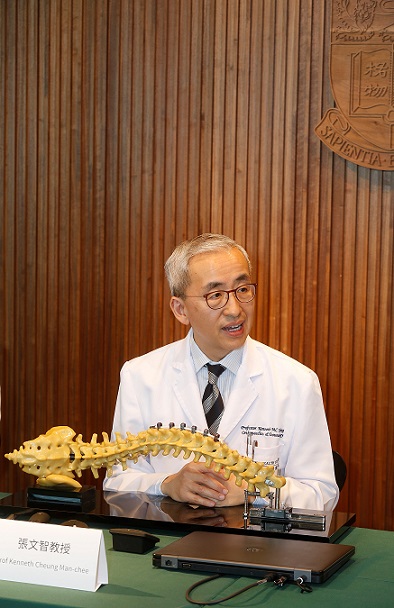22 May 2019
A surgical team led by the Department of Orthopaedics and Traumatology, LKS Faculty of Medicine, The University of Hong Kong (HKUMed), successfully performs the first non-fusion scoliosis surgery by vertebral body tethering in Hong Kong and China.
This new minimally invasive surgical technique is performed using keyhole incisions in the chest wall and utilises the remaining growth potential of the spine to gradually correct the patient’s spinal curvature. Its major advantage is in maintaining spinal mobility and avoids the use of an external brace or invasive fusion surgery. This new technique will benefit children with scoliosis with faster recovery rates, avoidance of large surgical wounds, and maintain spinal motion.
Background
Adolescent idiopathic scoliosis (AIS) is a three-dimensional deformity of the spinal column, resulting in a C- or S- shaped spine. It affects 3.5% of children in Hong Kong between the ages of 10 and 18, with a higher occurrence in girls and during puberty. Untreated scoliosis results in curve progression, back pain, reduced respiratory function, poor balance, cosmetic concerns and psychosocial effects. Traditionally, severe scoliosis requires treatment by surgery with a long open wound, dissection of back muscles, and surgical fusion with the implantation of rods and screws. While successful, traditional surgery renders the spine stiff and restricts individuals from certain activities.
Novel surgical technique
This procedure involves making five keyhole incisions, and allows clear visualisation of the spine via thoracoscopy (a camera view into the chest cavity). After dissection of the spine, under X-ray guidance, titanium screws are inserted at each level at the side of the spine (vertebral body). The screws are then connected via a non-rigid band (tether) that restricts growth on the convex side while allowing growth on the concave side, thereby achieving gradual curve correction as the spine grows over time.
This procedure is indicated in growing children affected by scoliosis of a moderate degree (40o to 60o curvature), and has been carried out mainly in selected centres in North America and Europe over the past eight years with good results. HKUMed is the first to introduce this procedure in Hong Kong and is the only centre in Greater China to have carried this out. The first surgery was carried out in February 2019 on a nine-year-old patient with scoliosis who required bracing. The child has recovered well and is back to full activities within a few weeks of surgery with no restrictions on activity or limitations in motion.
Significance of this novel surgical treatment
This new surgical technique utilises the patient’s own growth potential to allow gradual scoliosis correction over time. It does not require open surgery, and avoids long fusion of the spine, which may result in stiffness and adjacent level degeneration over time.
‟This new technique is the beginning of a new era in the surgical treatment of scoliosis. Children can look forward to normal activities without the psychological burden of bracing or effects of a long fusion surgery,” says Professor Kenneth Cheung Man-chee, Chair Professor and Head of Department of Orthopaedics and Traumatology, HKUMed.
About the surgical team
The surgery was led and carried out by Professor Kenneth Cheung Man-chee and Dr Kenny Kwan, Department of Orthopaedics and Traumatology, and Dr Kenneth Wong, Division of Paediatric Surgery, Department of Surgery, HKUMed. Professor Kenneth Cheung is the Head of Department of Orthopaedics and Traumatology, Chair Professor, Jessie Ho Professor of Spine Surgery; Dr Kenny Kwan is Clinical Assistant Professor subspecialising in Spine Surgery; Dr Kenneth Wong is Clinical Associate Professor and Chief of Division of Paediatric Surgery, Department of Surgery, with expertise in paediatric thoracoscopic surgery.
Professor Kenneth Cheung explained the non-fusion scoliosis surgery by vertebral body tethering.
(From left) Dr Kenneth Wong (Clinical Associate Professor and Chief of Division of Paediatric Surgery of Department of Surgery), patient’s mother Mrs Cho, Professor Kenneth Cheung (Head of Department of Orthopaedics and Traumatology) and Dr Kenny Kwan (Clinical Assistant Professor of Department of Orthopaedics and Traumatology).
Media enquiries
Please contact LKS Faculty of Medicine of The University of Hong Kong by email (medkefa@hku.hk).
Media enquiries
Please contact LKS Faculty of Medicine of The University of Hong Kong by email (medmedia@hku.hk).



Follow HKUMed